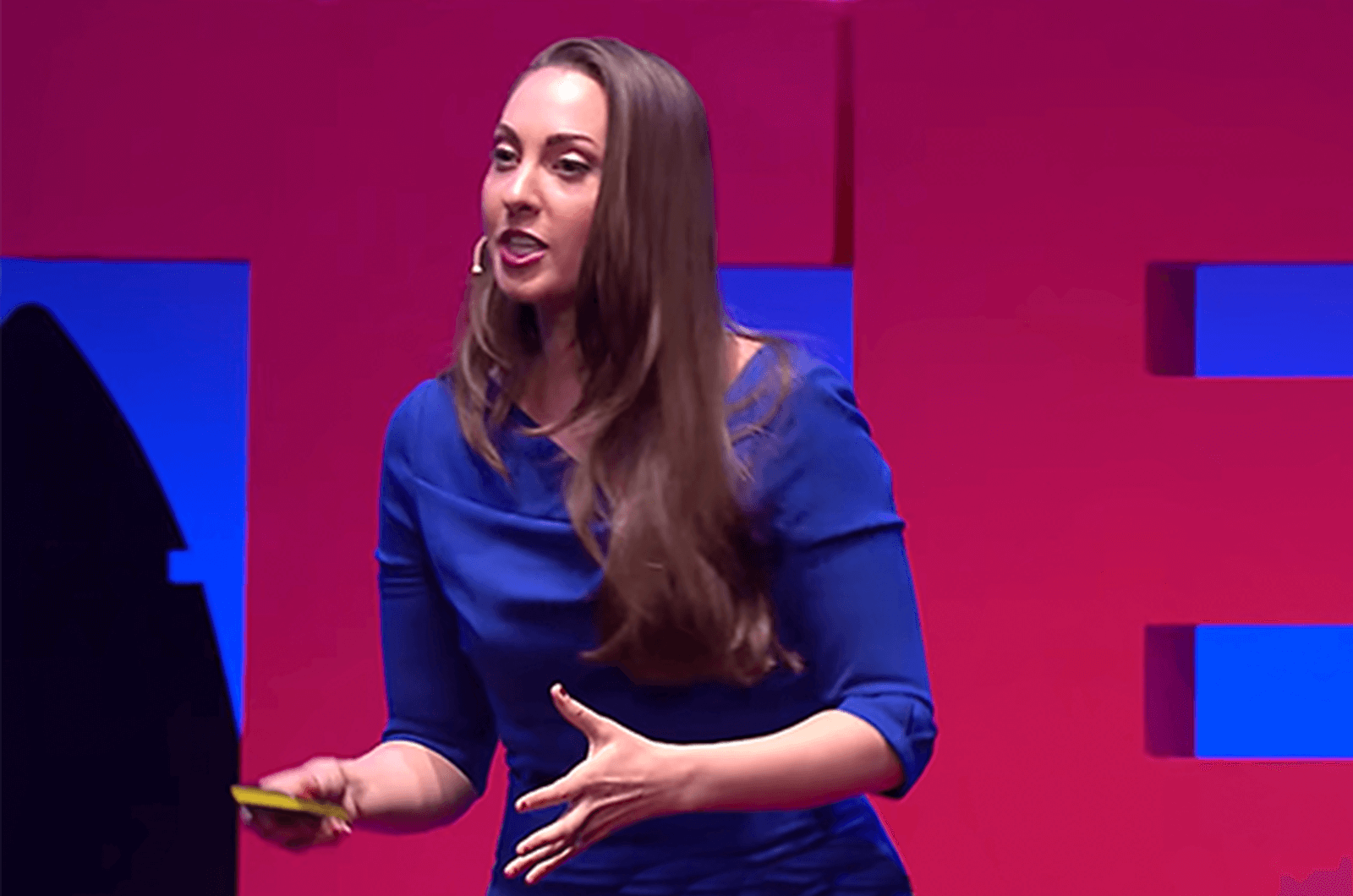What’s the difference between a memorable speech and one that is quickly forgotten? Researchers say hand gestures are key.
Speakers should strive to convey confidence and expertise through their stage presence. Nonverbal messaging—body language—is a key part of public speaking and has been a hot topic of research. What is it about a speaker’s gestures and posture that make audiences transition from being indifferent to engaged?
A few experts in particular have studied the effects of body language. Vanessa Van Edwards, David JP Phillips, and Jesse Scinto, DTM, have spent years analyzing the impact of body language on speeches. Van Edwards researches human behavior, communication, and the science of relationships, and delivered a TEDxLondon talk, “You Are Contagious.” She is the founder of Science of People, an organization based in Portland, Oregon, and author of Captivate: The Science of Succeeding with People.
When Van Edwards set out to study the factors separating viral TED Talks from other, less popular TED Talks, she learned that body language and nonverbal behaviors played a key role in how well speakers’ messages resonated with audiences.
Van Edwards agrees with the Toastmasters philosophy that effective use of body language helps speakers gain confidence, increases their influence, and allows them to become better presenters and professionals.
The Surprising Power of Body Language
In Van Edwards’ study of body language, 760 volunteers rated hundreds of hours of TED Talk videos posted on TED.com in 2010 to examine speakers’ body language and nonverbal patterns. Edwards discovered one eye-opening finding that stood out: There was no difference in the ratings of researchers who watched the TED Talks on mute with no text displayed and those who watched the talks with sound. Van Edwards says that discovery suggests that the nonverbal behaviors speakers employ—how they use their bodies to communicate rather than simply what they say—has more impact on audience perception than previously thought.

“We wanted to know if there were any big differences between the most popular TED speakers and the least popular, according to view count,” she says. “The biggest thing we noticed in the study was the correlation of the volume of hand gestures to high speaker ratings.” The lowest-rated TED Talks in her particular study had an average of 124,000 views and speakers used an average of 272 hand gestures during their 18-minute talks, she says. But the top-rated TED Talks had an average of 7.3 million views and used an average of 465 hand gestures.
It wasn’t just the number of hand gestures that separated the best TED Talks from the others, Van Edwards found, but rather the type of gestures speakers selected and how they were used.
“The best speakers used congruent gestures,” she says. “Those were gestures that added meaning or depth to words. If a TED speaker said they had a big idea, they held their hands out wide like carrying a heavy load. If a speaker said they had three ideas, they held up three fingers.”
What is it about a speaker's gestures and posture that make audiences transition from being indifferent to engaged?
Van Edwards has observed many speakers using various nonverbal techniques in her Science of People laboratories. “The biggest mistake people can make is thinking about nonverbals like an interpretive dance,” she says. “While hand gestures are incredibly powerful for comprehension, charisma, and fluency, there is such a thing as too much of a good thing.”
Rather than scripting speeches with nonverbal signs and interpreting every point with their hands, Van Edwards’ advice to speakers is “watch a video of yourself speaking to see where you naturally add hand gestures. These are where you can dial it up. If you feel unnatural doing a hand gesture, don’t do it. The audience picks up on that as well.”
Another nonverbal message also stood out as important: smiling. Whether or not a speaker had a funny or more serious topic, she says, “The more smiling, the higher the views.”
This finding helped free her as a speaker. “In the past I thought if I’m speaking about a serious topic, I’d better look serious,” she says. “Now I know we always want something to smile about, and [that] a little bit of laughter helps with retention and learning.”
Body Language and “Thin Slicing”
The term “thin slicing” refers to the tendency to judge others within moments of meeting them or seeing them walk onstage to speak. Van Edwards’ TED Talks research found that nonverbal behaviors have an outsized impact on these first impressions. Viewers decide if they like a TED Talk within the first seven seconds, she says, and that impression has very little to do with the words speakers use.
“As speakers, we often forget that our first impression happens before we even start speaking,” Van Edwards says. “It happens when you are doing your technology check or even when you’re in the audience waiting for the event to start. Don’t forget that your stage presence starts the moment you walk into the room.”
While you’re interacting with the audience before a speech, Van Edwards advises having “visible hands,” making eye contact with people as you walk by, relaxing your shoulders, and keeping your head and chest high.
Importance of Synchronizing Nonverbals and Speech
Other researchers around the world have conducted their own studies on the use of body language and nonverbal patterns in public speaking. David JP Phillips, an international speaker, author, and CEO of a presentation-skills training company in Västerås, Sweden, spent seven years studying 5,000 speakers around the world. From that research, Phillips was able to distill 110 separate skills that help separate great from good speakers. The study is fully detailed in Phillips’ TEDxZagreb Talk, “The 110 Techniques of Communication and Public Speaking.”

While hand and arm gestures are a key part of body language, Phillips says the details of posture—how we stand and move on stage, even tilting our head—not only help the audience to pay attention to your message but also help us feel more confident onstage. He emphasizes using “open” versus “closed” body language. So rather than crossing your arms or placing them in pockets, or taking a step back when speaking, focus on keeping your arms by your side when not using them to gesture, lean slightly forward to make a point, and have your body weight equally centered over both legs. Even how the head is positioned matters: Tilt it slightly forward toward the audience as part of your open body language, and tilt it slightly to one side to show empathy.
The details of posture—how we stand and move onstage, even tilting our head—not only helps the audience to pay attention but also help us feel more confident onstage.
Phillips agrees with Van Edwards that hand gestures should have a specific purpose and match the message. “The best speakers also used a distinct stop to hand movements they made either out to the left or right, rather than a ‘sloppy’ stop,” he says. “That distinct ending of a gesture was associated with higher credibility.”
Phillips also found that many speakers struggled with effectively using facial expressions to support their spoken messages. “It was unusual in the research to see a well-animated face,” he says. “That is problematic because it’s the part of your body an audience tends to look at the most.” Besides the benefits to the audience of a speaker’s warm smile, Phillips points out it delivers benefits to the speaker as well. In an Ideas.TED.com article he says, “As our emotions work from the inside out and the outside in, it means that you can affect your own emotional state in a positive way by smiling on stage.”
Those speakers in his research who mastered the use of body language demonstrated a high level of synchronicity between their gestures, mannerisms, and words. “If your movements aren’t carefully synchronized with what you’re saying, it causes a disturbance for your audience.”
Using Three Types of Gestures Effectively
Jesse Scinto, DTM, a member of Greenspeakers Club in New York, New York, and a professor of strategic communication at Columbia University in New York City, also is an expert in the use of body language in public speaking. Scinto says while it’s common for people to group all hand gestures in one category, in reality three different types of gestures should be used selectively, based on the intent of spoken words.
Scinto, who also is CEO of the company Public Sphere, which conducts presentation skills training, classifies gestures in three different categories: dramatic hand gestures that should be used to act out scenes or actions being described; emphatic gestures to drive home or underscore a point; and orchestrated gestures, the scripted kind often used by television broadcasters to help clarify or highlight messages. “It’s important to make a conscious decision about which of the three gestures you’ll use for specific purposes,” he says.
Scinto recommends being intentional about how you move on stage or in front of an audience. “Some speakers like to walk while they speak, but there is a risk of looking like a caged tiger if it’s not done right,” he says. Instead, he recommends to stand still and plant your feet before delivering a thought or point. “The more settled you look, the more authoritative you usually look,” Scinto says. “If you do need to move, pause your speech, walk to where you’d like to go, and only then start speaking again after you’ve stopped moving.”
Consider how this research on body language can help you perfect your craft. By studying lessons from these findings, you can choose and apply the nonverbal behaviors proven to have the biggest impact on audience perception and content retention.
Editor’s Note: “Effective Body Language” is a Level 3 elective project available in all 11 paths in the Pathways program.
Dave Zielinski is a freelance writer in Minneapolis, Minnesota, and a frequent contributor to the Toastmaster magazine.



 Previous
Previous
 How Body Language Matters When Speaking Online
How Body Language Matters When Speaking Online
 Previous Article
Previous Article

